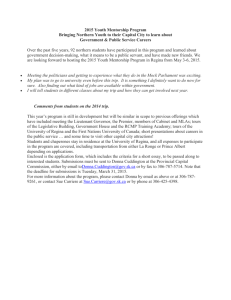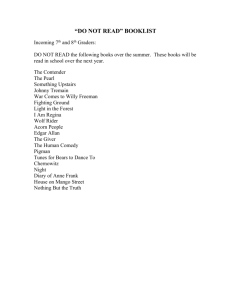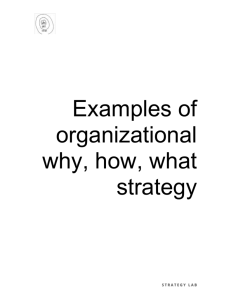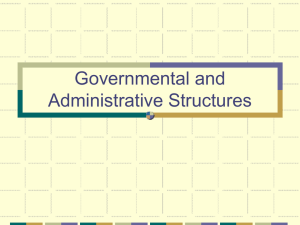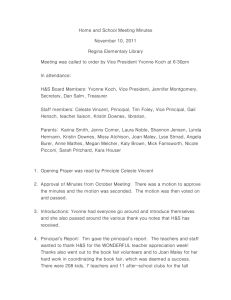Judicial Discretions - Office of the Director of Public Prosecutions
advertisement
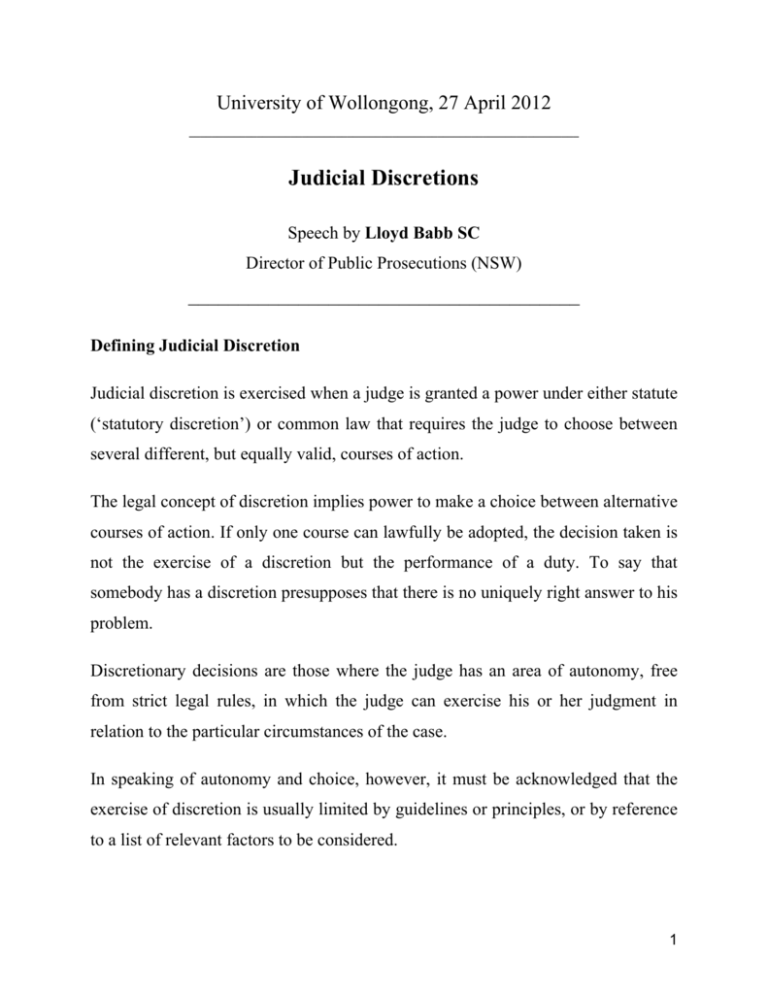
University of Wollongong, 27 April 2012 _____________________________________________________________________ Judicial Discretions Speech by Lloyd Babb SC Director of Public Prosecutions (NSW) _______________________________________ Defining Judicial Discretion Judicial discretion is exercised when a judge is granted a power under either statute (‘statutory discretion’) or common law that requires the judge to choose between several different, but equally valid, courses of action. The legal concept of discretion implies power to make a choice between alternative courses of action. If only one course can lawfully be adopted, the decision taken is not the exercise of a discretion but the performance of a duty. To say that somebody has a discretion presupposes that there is no uniquely right answer to his problem. Discretionary decisions are those where the judge has an area of autonomy, free from strict legal rules, in which the judge can exercise his or her judgment in relation to the particular circumstances of the case. In speaking of autonomy and choice, however, it must be acknowledged that the exercise of discretion is usually limited by guidelines or principles, or by reference to a list of relevant factors to be considered. 1 While the Uniform Evidence Law refers to Part 3.11 – Discretions to Exclude Evidence, at first glance one can see that those discretions are not absolute and are limited by the statutory guidelines discussed below. In Australia, judges have also developed principles for the review by appellate courts of discretionary decisions and this indirectly regulates the exercise of discretionary powers. The leading authority in this regard is House v The King (1936) 55 CLR 499. This case established that appellable errors committed in the exercise of a discretion include: acting upon a wrong principle; allowing extraneous or irrelevant matters to guide the discretion; mistaking the facts and failing to take account of a material consideration. However, it will not be enough that the appellate court would have exercised the discretion differently. Instead, the discretion must involve an error of law which has led to ‘an unreasonable or plainly unjust’ result, or has involved a ‘substantial wrong’, before the discretion will be taken to have been improperly exercised by the lower court. DISCRETIONS ABOUT THE ADMISSION OF EVIDENCE Uniform Evidence Legislation Although the uniform evidence legislation ‘is not a restatement in statutory form of common law and existing statutory rules of evidence’ (Stephen Odgers, Uniform Evidence Law 1.1.80), substantial similarities do exist in the area of discretionary exclusion of evidence. Care should be taken in interpreting the provisions of the Uniform Evidence legislation in the context of pre-existing law. 2 Just one example of a significant difference can be seen between the Bunning v Cross public policy discretion and s.138. The common law judicial discretion to exclude evidence on the basis of public policy has been substantially replicated in s.138 of the Uniform Evidence legislation. There is, however, one major difference. Under the common law, evidence tainted by police misconduct is prima facie admissible with the trial judge having the discretion to exclude it. Under the statute, however, such evidence is prima facie inadmissible, although the trial judge has a discretion to allow its admission. This therefore shifts the onus away from the defendant once the illegality has been satisfactorily made out. The onus is on the prosecution to convince the judge to admit the evidence obtained through the illegality. Section 90: The Unfairness Discretion A trial judge has a discretion to reject an admission if, 'having regard to the circumstances in which it was made', it would be unfair to the defendant to admit it: s.90 Evidence Act. Relevant cases: Tofilau v R (2007) 238 ALR 650 EM v R (2007) 238 ALR 650 R v Swaffield; Pavic v R (1998) 192 CLR 159 The concept of unfairness in the Evidence Act has been expressed in the widest possible terms: Swaffield (1998) 192 CLR 159. The concept of fairness appears to now cover all matters where the accused's freedom to choose whether to speak to 3 the police has been impugned, and where the evidence has been obtained at a price which is unacceptable having regard to community standards: Swaffield. It is not clear whether the reliability of the evidence is an important factor in relation to s.90. The authorities relating to the common law unfairness discretion made it clear that the reliability of the confession is an important factor in the question of fairness, but it is not the only factor. However in Regina v Em [2006] NSWCCA 336 the CCA said that reliability is less significant in a consideration of s.90 because of the separate existence of s.85 which makes unreliable confessions inadmissible: see para [68]. The High Court appears to be evenly divided on the issue of the significance of the reliability of the evidence in making a determination under s.90. In Em v The Queen [2007] HCA 46 the majority position was made up of Gleeson CJ and Heydon J, Gummow and Hayne JJ. Gleeson CJ and Heydon J took the common law position that reliability was an important but not exclusive factor (see esp paras [72] and [73]). However, Gummow and Hayne JJ expressed the view that s.90 was in effect a 'safety net' to be engaged only after the other provisions (such as s.85) are found not to apply, so that questions of reliability and illegality are irrelevant (see esp at para [109]). In making a determination under s.90, the probative value of the evidence is of little relevance: Regina v Sophear Em [2003] NSWCCA 374 at para [110], and it is incorrect to weigh up the probative value of the evidence against prejudicial value (unlike the discretion under s.137 Evidence Act). In Higgins v Regina [2007] NSWCCA 56 the trial judge refused to reject an interview between bank investigators investigating a fraud and a bank manager, 4 where there was no caution. The appeal arguing that the interview should have been rejected on the basis of s.90 was unsuccessful: see especially at para [37]. Regina v Frangulis [2006] NSWCCA 363 was a case where an insurance investigator interviewed the accused about a fire without telling him that he was a suspect and without cautioning him. It was held that the trial judge was in error in not admitting the interview into evidence under the s.90 discretion. Covert recordings Section 90 is particularly relevant to covertly recorded conversations. This is partly because, where the person speaking to the accused is not a police officer, there will not normally be an obligation to give a caution, and as a result s.138 (as to which see below) is unlikely to be triggered. Regina v Em [2006] NSWCCA 336 was a case where a suspect was cautioned by police, and the suspect said that he would not agree to a recorded interview. Police then obtained a listening device warrant, and covertly recorded a conversation with Em in which he made admissions. It was held that there was no error because the police had not deliberately caused Em to wrongly believe that the record of interview could not be used against him: see Em v The Queen (2007) 81 ALJR 1896. In a case where the police covertly record a conversation between a suspect and person acting as an agent of the police, the Court of Criminal Appeal has said that the following principles apply (in Regina v Pavitt [2007] NSWCCA 88 at para [70]): 5 (a) The underlying consideration in the admissibility of covertly recorded conversations is to look at the accused's freedom to choose to speak to the police and the extent to which that freedom has been impugned: Swaffield (at [91]) per Toohey, Gaudron and Gummow JJ; (at [155]) per Kirby J. (b) If that freedom is impugned, the court has a discretion to reject the evidence, the exercise of which will turn on all the circumstances which may point to unfairness to the accused if the confession is admitted: Swaffield (at [91]); (c) Even if there is no unfairness the court may consider that, having regard to the means by which the confession was elicited, the evidence has been obtained at a price which is unacceptable having regard to prevailing community standards: Swaffield (at [91]). (d) The question whether the conversation was recorded in circumstances such that it might be characterised as either unfair and/or improper include whether the accused had previously indicated that he/she refused to speak to the police; (e) The right to silence will only be infringed where it was the informer who caused the accused to make the statement, and where the informer was acting as an agent of the state at the time the accused made the statement. Accordingly, two distinct inquiries are required: a. as a threshold question, was the evidence obtained by an agent of the state? b. was the evidence elicited? (f) A person is a state agent if the exchange between the accused and the informer would not have taken place, in the form and manner 6 in which it did take place, but for the intervention of the state or its agents; (g) Absent eliciting behaviour on the part of the police, there is no violation of the accused’s right to choose whether or not to speak to the police. If the suspect speaks, it is by his or her own choice, and he or she must be taken to have accepted the risk that the recipient may inform the police; (h) Admissions will have been elicited if the relevant parts of the conversation were the functional equivalent of an interrogation and if the state agent exploited any special characteristics of the relationship to extract the statement; evidence of the instructions given to the state agent for the conduct of the conversation may also be important; (i) The fact that the conversation was covertly recorded is not, of itself, unfair or improper, at least where the recording was lawful. Section 135 - General Discretion to Exclude Prejudicial Evidence In both civil and criminal matters the court has a general discretion to exclude evidence whose probative value is substantially outweighed by the danger that the evidence might be unfairly prejudicial to a party, or misleading and confusing, or cause or result in an undue waste of time: s.135 Evidence Act. This provision is something of a dead letter in criminal proceedings, because it becomes subsumed in the much broader discretion given by s.137, discussed immediately below. Section 137 - Exclusion of Prejudicial Evidence in Criminal Proceedings 7 The court must refuse to admit evidence in criminal proceedings if its probative value is outweighed by the danger of unfair prejudice to the defendant: s.137 Evidence Act. To the extent that the exclusion is mandatory it is incorrect to refer to s.137 as creating a discretion. However, in Gonzales v R [2007] NSWCCA 32, Giles JA observed simply at [55] that the provision is “akin to a discretion so far as it calls for evaluative judgment”. Similarly in Smale v R [2007] NSWCCA 328, Howie J stated at [32] that an appeal court “will not hold that the discretionary judgment that the application of the section involves has been wrongly determined in favour of the Crown unless it was not reasonably open for the trial judge to admit the evidence”. However, once the court has found that the probative value of the evidence is outweighed by the danger of unfair prejudice, there is no residual discretion; the evidence must be excluded: Blick (2000) 111 A Crim R 326. It has been held that in considering the probative value of the challenged evidence, the evidence is to be considered on the assumption that it will be accepted, so matters of reliability will only rarely be relevant: Shamouil [2006] NSWCCA 112. In R v Sood [2007] NSWCCA 214, the Court considered a Crown appeal in respect of an interlocutory ruling by a trial judge that evidence said by the Crown to support an inference of consciousness of guilt of the offences charged was “not strongly probative” because an alternative inference was much more plausible. The Court not only accepted that “questions of credibility and reliability … play no part in the assessment of the probative value of evidence sought to be admitted in the Crown case” (Latham J at [36]), it was held that “it was no part of the trial judge’s function in assessing probative value under s 137 to have regard to competing 8 explanations for the respondent’s conduct, other than that upon which the Crown relied” (at [40]). This conclusion appears to have been premised on a view that s 137 requires the judge to consider only “the Crown case” in assessing probative value, but there is nothing in the provision that gives any support to such a narrow approach. It effectively excludes an independent role for the trial judge to exclude evidence of little real significance that also creates a perceptible risk of a miscarriage of justice in a criminal trial. There was no appeal to the High Court in respect of Shamouil. There was an application for special leave to appeal in Sood, but this was refused on the basis that it was exceptional for the High Court to grant special leave to appeal in interlocutory matters and Sood was subsequently acquitted. The Tasmanian Court of Criminal Appeal has not adopted the narrow approach to this provision taken by the NSW Court of Criminal Appeal in R v Shamouil (2006) 66 NSWLR 228; [2006] NSWCCA 112. In Director of Public Prosecutions (Tas) v Lynch (2006) 166 A Crim R 327; [2006] TASSC 89 the Tasmanian Court of Criminal Appeal applied s 137 in respect of identification evidence and held that “the probative value of the evidence was adversely affected by a number of factors” that reduced the reliability of the identification (Blow J at [18], [39]). Stephen Odgers is of the view that it likely that the High Court will have to rule on these issues and determine which approach is correct in the future (Uniform Evidence Law February 2008 update). 'The danger of unfair prejudice' means that there is a real risk that the jury will misuse the evidence in some unfair way: Regina v Sophear Em [2003] NSWCCA 374 at para [120], Regina v BD (1997) 94 A Crim R 131 at 139, Papakosmas v The 9 Queen (1999) 196 CLR 297 at para [91] (per McHugh J). It is necessary for the trial judge to identify the asserted danger of unfair prejudice: Regina v RN [2005] NSWCCA 413 esp at para [11]. In the case of prior criminal conduct, the danger of unfair prejudice may be the risk that knowing of the prior criminal conduct of the accused, the jury might be diverted from a proper consideration of the evidence and simply assume the accused's guilt: for example, see Regina v Watkins (2005) 153 A Crim R 434 esp at paras [49] to [50]. Judicial minds many differ on the extent of any “unfair prejudice” for the purposes of this provision. An example is in the case of Evans v The Queen (2007) 82 ALJR 250; [2007] HCA 59. Security cameras had photographed an armed man wearing overalls, sunglasses, and a balaclava robbing persons of money. Similar overalls and a similar balaclava were found at the home of the appellant. He was required to wear those overalls and balaclava (as well as a pair of sunglasses similar to those worn by the robber) in front of the jury, for the suggested purpose of comparing his appearance with the appearance of the robber in the security photographs (and descriptions of the robber given by witnesses). Gummow and Hayne JJ held that evidence of the appearance of the appellant wearing the balaclava, overalls, and sunglasses was not relevant evidence and accordingly, he should not have been required to wear them. The other members of the Court held that the evidence was relevant but came to different conclusions regarding the application of this provision. Heydon J (with whom Crennan J agreed) held at [226] that “there was no unfair prejudice”, apart from the “unduly long time during which the accused wore the balaclava” while legal argument about the procedure proceeded, which he 10 considered (at [185]) “brief and insignificant’ when “[v]iewed in the context of the case as a whole. In contrast, Kirby J held at [108] – [109] that here was a high level of “unfair prejudice”: It is not correct to dismiss the prejudice to the appellant as insubstantial because of the fact that he was obliged to sit in the witness box for a relatively short time, measured against the duration of the entire trial, during the part of which the jury’s attention would have been distracted and focused on the objections being voiced by the appellant’s trial counsel…The duration of the demonstration is not the essence of the appellant’s complaint. The complaint is that the prosecutor’s questions made him sit, in the jury’s presence, in a garb often associated with armed robberies; inescapably similar to the appearance of the offender shown on the video film and photographic stills; and necessarily looking sinister and criminal-like. Even if glanced at for a moment, such an image (like images of hijackers, terrorists and murders in well-remembered films, documentaries and news broadcasts) would etch an eidetic imprint on the jury’s collective mind. It is an image unfairly prejudicial to the appellant… [N]ever in my experience has conduct in which the accused person has been asked to engage come close to the serious prejudice to which the appellant was subjected by the questioning by the prosecutor and the demonstration that she led him to perform in his trial. In weighing up the probative value of the evidence with the danger of unfair prejudice, the judge must consider whether the prejudice could be cured by directions: see Regina v Cook [2004] NSWCCA 52 at para [37] and Regina v 11 Ngatikaura [2006] NSWCCA 161 at para [32]. In this balancing exercise, the interest of the community in seeing offenders convicted is irrelevant: Kovacs (2000) 111 A Crim R 374. Section 136 - Limiting the Use of Evidence There is a discretion to limit the use of evidence if there is a danger that a particular use of the evidence might be unfairly prejudicial to a party or misleading or confusing: s.136 Evidence Act. If the use of evidence is limited to the fact that something was said, the jury should be specifically directed that the evidence of the conversation cannot be used as proof of the fact asserted: Livingstone [2004] NSWCCA 122. Section 138 - Illegally or Improperly Obtained Evidence There is a discretion to admit evidence which was illegally or improperly obtained: see s.138 Evidence Act and the Chapter on Illegally Obtained Evidence. Section 138 states that evidence which is obtained improperly or in contravention of an Australian law is not to be admitted unless the desirability of admitting the evidence outweighs the undesirability of admitting evidence so obtained. The following matters must be taken into account (this list is not exhaustive): (a) the probative value of the evidence, and (b) the importance of the evidence in the proceeding, and (c) the nature of the relevant offence, cause of action or defence and the nature of the subject-matter of the proceeding, and 12 (d) the gravity of the impropriety or contravention, and (e) whether the impropriety or contravention was deliberate or reckless, and (f) whether the impropriety or contravention was contrary to or inconsistent with a right of a person recognised by the International Covenant on Civil and Political Rights, and (g) whether any other proceeding (whether or not in a court) has been or is likely to be taken in relation to the impropriety or contravention, and (h) the difficulty (if any) of obtaining the evidence without impropriety or contravention of an Australian law (s.138 (3) Evidence Act). It has been held that the gravity of the offence is a factor in favour of not exercising the discretion under s.138 Evidence Act: Dalley (2002) 139 A Crim R 169. Thus where the offence charged is a serious one, that weighs against excluding the evidence: Regina v Camilleri [2007] NSWCCA 36 esp at para [33]. Where the illegality was due to a genuine mistake, rather than deliberate, the level of impropriety may be low, and that will militate in favour of admitting the evidence: Regina v Camilleri [2007] NSWCCA 36 at para [29]. Evidence obtained interstate, in compliance with interstate law, but not in compliance with NSW law, is not illegally or improperly obtained evidence within the meaning of s.138: Workman [2004] NSWCCA 213. A consideration of whether material should be admitted under s.138 does not involve a consideration of fairness to the accused (unlike s.90 Evidence Act) or 13 oppression of the accused (unlike s.84 Evidence Act): Regina v Sophear Em [2003] NSWCCA 374 esp at para [74]. Improperly Obtained Admissions. An admission made during or in consequence of questioning is taken to have been obtained improperly if the person questioning: did an act or omission which he knew or ought to have known would substantially impair the ability of the suspect to answer the question or made a false statement where the questioner knew or ought to have known it was false, and that it was likely to cause the suspect to make an admission: s.138(2) Evidence Act. Failure to Caution A statement is obtained improperly if the person questioned was not cautioned in a language the person could communicate in with reasonable fluency, the questioner had the power to arrest him, and the person was under arrest (s.139(1)) the official believed there was sufficient evidence to arrest him (s.139 (5) (a)) the official would not have allowed the person to leave if the person had wished to do so (s.139 (5)(b)), or the official has given the person reasonable grounds for believing he would not be able to leave (s.139 (5)(c)). Where the questioner is an investigating official with no power of arrest, a statement is obtained improperly if the person is not cautioned and the 14 investigating official believes there is sufficient evidence to establish his guilt (s.139 (2)). 'Investigating official' is defined in the Dictionary as meaning (in summary) a police officer or another person appointed under Australian law to investigate or prevent the commission of offences. As a result it would appear that there is no requirement for a private investigator to give a caution, such as a bank investigator investigating a fraud who interviews a bank manager (as in Higgins v Regina [2007] NSWCCA 56 esp at paras [34] and [37]). The provision may apply to interrogation by undercover police officers: Swaffield (1998) 192 CLR 159. 15 BIBLIOGRAPHY Stephen Odgers, Uniform Evidence Law, Lawbook Company looseleaf service John Stratton, Criminal Law Survival Kit, NSW Public Defenders Office website: http://www.lawlink.nsw.gov.au/lawlink/pdo/ll_pdo.nsf/pages/PDO_index CASES CITED House v The King (1936) 55 CLR 499 Bunning v Cross Tofilau v R (2007) 238 ALR 650 EM v R (2007) 238 ALR 650 R v Swaffield; Pavic v R (1998) 192 CLR 159 Regina v Em [2006] NSWCCA 336 Em v The Queen [2007] HCA 46 Regina v Sophear Em [2003] NSWCCA 374 Higgins v Regina [2007] NSWCCA 56 Regina v Frangulis [2006] NSWCCA 363 Regina v Pavitt [2007] NSWCCA 88 Gonzales v R [2007] NSWCCA 32 Smale v R [2007] NSWCCA 328 Blick (2000) 111 A Crim R 326 Shamouil [2006] NSWCCA 112 R v Sood [2007] NSWCCA 214 R v Shamouil (2006) 66 NSWLR 228; [2006] NSWCCA 112 Director of Public Prosecutions (Tas) v Lynch (2006) 166 A Crim R 327; [2006] TASSC 89 16 Regina v SJRC [2007] NSWCCA 142 Regina v BD (1997) 94 A Crim R 131 at 139 Papakosmas v The Queen (1999) 196 CLR 297 Regina v RN [2005] NSWCCA 413 Regina v Watkins (2005) 153 A Crim R 434 Regina v Cook [2004] NSWCCA 52 Regina v Ngatikaura [2006] NSWCCA 161 Kovacs (2000) 111 A Crim R 374 Livingstone [2004] NSWCCA 122 Evidence Act: Dalley (2002) 139 A Crim R 169 Regina v Camilleri [2007] NSWCCA 36 Workman [2004] NSWCCA 213 Swaffield (1998) 192 CLR 159, 72 ALJR 339, (1997) 96 A Crim R 96 Makarian v The Queen (2005) 2214 ALR 213 17 Annexure – Relevant Uniform Evidence Legislation Provisions 90 Discretion to exclude admissions In a criminal proceeding, the court may refuse to admit evidence of an admission, or refuse to admit the evidence to prove a particular fact, if: (a) the evidence is adduced by the prosecution, and (b) having regard to the circumstances in which the admission was made, it would be unfair to a defendant to use the evidence. Note. Part 3.11 contains other exclusionary discretions that are applicable to admissions. Part 3.11 Discretions to exclude evidence 135 General discretion to exclude evidence The court may refuse to admit evidence if its probative value is substantially outweighed by the danger that the evidence might: (a) be unfairly prejudicial to a party, or (b) be misleading or confusing, or (c) cause or result in undue waste of time. 136 General discretion to limit use of evidence The court may limit the use to be made of evidence if there is a danger that a particular use of the evidence might: (a) be unfairly prejudicial to a party, or (b) be misleading or confusing. 137 Exclusion of prejudicial evidence in criminal proceedings 18 In a criminal proceeding, the court must refuse to admit evidence adduced by the prosecutor if its probative value is outweighed by the danger of unfair prejudice to the defendant. 138 Exclusion of improperly or illegally obtained evidence (1) Evidence that was obtained: (a) improperly or in contravention of an Australian law, or (b) in consequence of an impropriety or of a contravention of an Australian law, is not to be admitted unless the desirability of admitting the evidence outweighs the undesirability of admitting evidence that has been obtained in the way in which the evidence was obtained. (2) Without limiting subsection (1), evidence of an admission that was made during or in consequence of questioning, and evidence obtained in consequence of the admission, is taken to have been obtained improperly if the person conducting the questioning: (a) did, or omitted to do, an act in the course of the questioning even though he or she knew or ought reasonably to have known that the act or omission was likely to impair substantially the ability of the person being questioned to respond rationally to the questioning, or (b) made a false statement in the course of the questioning even though he or she knew or ought reasonably to have known that the statement was false and that making the false statement was likely to cause the person who was being questioned to make an admission. (3) Without limiting the matters that the court may take into account under subsection (1), it is to take into account: (a) the probative value of the evidence, and (b) the importance of the evidence in the proceeding, and (c) the nature of the relevant offence, cause of action or defence and the nature of the subject-matter of the proceeding, and (d) the gravity of the impropriety or contravention, and (e) whether the impropriety or contravention was deliberate or reckless, and 19 (f) whether the impropriety or contravention was contrary to or inconsistent with a right of a person recognised by the International Covenant on Civil and Political Rights, and (g) whether any other proceeding (whether or not in a court) has been or is likely to be taken in relation to the impropriety or contravention, and (h) the difficulty (if any) of obtaining the evidence without impropriety or contravention of an Australian law. Note. The International Covenant on Civil and Political Rights is set out in Schedule 2 to the Human Rights and Equal Opportunity Commission Act 1986 of the Commonwealth. 139 Cautioning of persons (1) For the purposes of section 138 (1) (a), evidence of a statement made or an act done by a person during questioning is taken to have been obtained improperly if: (a) the person was under arrest for an offence at the time, and (b) the questioning was conducted by an investigating official who was at the time empowered, because of the office that he or she held, to arrest the person, and (c) before starting the questioning the investigating official did not caution the person that the person does not have to say or do anything but that anything the person does say or do may be used in evidence. (2) For the purposes of section 138 (1) (a), evidence of a statement made or an act done by a person during official questioning is taken to have been obtained improperly if: (a) the questioning was conducted by an investigating official who did not have the power to arrest the person, and (b) the statement was made, or the act was done, after the investigating official formed a belief that there was sufficient evidence to establish that the person has committed an offence, and (c) the investigating official did not, before the statement was made or the act was done, caution the person that the person does not have to say or 20 do anything but that anything the person does say or do may be used in evidence. (3) The caution must be given in, or translated into, a language in which the person is able to communicate with reasonable fluency, but need not be given in writing unless the person cannot hear adequately. (4) Subsections (1), (2) and (3) do not apply so far as any Australian law requires the person to answer questions put by, or do things required by, the investigating official. (5) A reference in subsection (1) to a person who is under arrest includes a reference to a person who is in the company of an investigating official for the purpose of being questioned, if: (a) the official believes that there is sufficient evidence to establish that the person has committed an offence that is to be the subject of the questioning, or (b) the official would not allow the person to leave if the person wished to do so, or (c) the official has given the person reasonable grounds for believing that the person would not be allowed to leave if he or she wished to do so. (6) A person is not treated as being under arrest only because of subsection (5) if: (a) the official is performing functions in relation to persons or goods entering or leaving Australia and the official does not believe the person has committed an offence against a law of the Commonwealth, or (b) the official is exercising a power under an Australian law to detain and search the person or to require the person to provide information or to answer questions. 21

